With just days remaining before the 2024 Presidential Election, the latest voter registration updates from Pennsylvania indicate a diminishing Democratic advantage that has characterized the state’s political landscape since the Obama years. The data reveals a significant shift: in late October 2016, Democrats led by 911,621 registrations, but as of now, the margin has been slashed to 281,091. The Republican Party has made notable gains in voter registrations, reducing the Democratic edge from 700,853 in 2020 to the current figure. It’s crucial to acknowledge that while these changes suggest rising support for the GOP, they do not directly predict election outcomes. The current trend may reflect a growing number of long-term Democratic voters officially switching their affiliations rather than new voters joining the Republican ranks. This backdrop sets the stage for both Vice President Kamala Harris and former President Donald Trump to strategize effectively in their quests for Pennsylvania’s vital 19 electoral votes.
Diving deeper into voter registration dynamics, the shifts vary significantly across different regions of Pennsylvania. In central counties, for instance, the GOP has made strong inroads with notable gains such as R+1,444 in Blair County and R+1,055 in Clearfield County. Even demographic centers like Centre County, home to Penn State University, have not yielded Democratic gains despite an influx of college students. Trump aims to entice young male voters as he campaigns in State College, illustrating the importance of every county’s margins in the statewide tally. In northeastern Pennsylvania, Luzerne County’s shift to Republican registration dominance marks a critical pivot, especially given Trump’s past successes there. Harris may need to work harder to replicate Joe Biden’s performance from four years ago, particularly with significant support for local candidates like Bob Casey and Matt Cartwright riding on a wave of recent federal funding for infrastructure improvements.
The Northwest region of Pennsylvania showcases a similar trend as voter registrations reflect an upward trajectory for the GOP, although Democrats still maintain a lead in certain bellwether counties like Erie, which historically align with statewide electoral winners. Erie County presents a particularly interesting battleground, as all major candidates have hosted rallies to capitalize on its election significance. Meanwhile, in South Central Pennsylvania, Republicans continue to hold an advantage in key populations. This includes regions like Lancaster and York, where educated white voters might initially lean Democratic but have been swayed by wider GOP messaging. Meanwhile, Harris’s strategy targets both urban and suburban outlets to amplify her support, especially underlining her differences with Trump and securing an anti-Trump narrative.
The Southeast region tells a mixed tale for Democrats, with Philadelphia showing a slight advantage in registrations but the surrounding collar counties seeing substantial Republican gains. Voter demographics in these suburbs—Bucks, Chester, Delaware, and Montgomery—are pivotal to Harris’s electoral strategy. She cannot underperform here if she hopes to match or surpass Biden’s numbers from 2020. An important subplot emerges in the Lehigh Valley, where demographics may yield surprising results. Cities such as Allentown, with a significant Puerto Rican population, could shift the balance in Harris’s favor if she can engage these voters effectively.
Similarly, the Southwest region remains a crucial area for both campaigns. Trump’s prior success in this territory significantly impacted the 2016 election and reinforced the necessity for Democratic candidates to perform well in urban areas, particularly Allegheny County, which had seen successful Democratic outings in recent elections. Despite the Republican gains in other regions, the Harris campaign still has an opportunity to counteract those trends. They are focused on increasing turnout in urban centers and maintaining their foothold among traditionally Democratic voter bases.
As Election Day approaches, the critical factor for both parties becomes margin management; Trump aims to optimize his hold in rural areas while simultaneously reducing Harris’s support in urban settings. Voter turnout indicators suggest that every single vote could make a difference, given the razor-thin margins of previous contests. Harris’s campaign strategy emphasizes that she must not only rally support in the South Central region but also consolidate her gains in urban areas to recover lost ground since the prior election. Historical voting patterns in Southeastern Pennsylvania reveal that campaign efforts need to yield closer margins to provide a competitive edge across the state. In an election where every electoral vote counts, Pennsylvania stands as a vital battleground, making each voter’s decision pivotal in shaping the nation’s political future.

